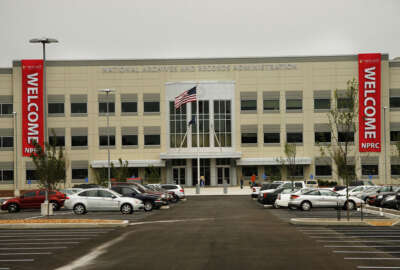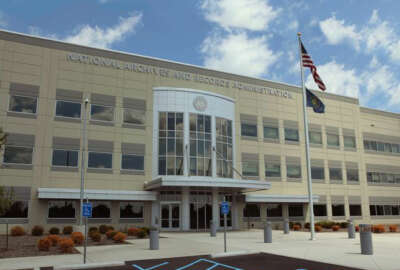

The Veterans Benefits Administration is helping the National Archives and Records Administration expand its pandemic operations and is scanning decades of...
The Department of Veterans Affairs has launched an effort to digitally scan all paper-based military personnel files, an initiative the agency said should help resolve its current backlog and better prepare VA for future challenges that may disrupt disability claims processing.
The initiative is part of a partnership VA has with the National Archives and Records Administration to proactively scan millions of military personnel records, which the National Personnel Records Center (NPRC) stores on behalf of the federal government in more than a dozen warehouses in St. Louis.
Veterans need those documents to access certain burial services, medical treatment, home loans and other benefits from VA, and the Veterans Benefits Administration needs those records to begin processing disability claims.
But some veterans have struggled to access their records during the pandemic, delaying an already complex disability claims process for many.
“Getting these federal records faster allows us to advance to the next stage [of the disability claims process],” Ken Smith, deputy assistant secretary for field operations, told reporters last week. “We have to know some facts and circumstances about service in order to determine whether or not we should order a [compensation and pension] exam. That’s the next touch point where we have to seek input from an external partner in order to complete the claim.”
The NPRC sent the vast majority of its employees home to telework last March at the start of the pandemic, meaning it didn’t have enough personnel available to pull paper records from the shelves, handle them and send them to VA so it can begin its own lengthy disability claims process.
By last September, VBA had nearly 80,000 veterans’ claims awaiting records from the NPRC, the department said.
The delay for records was just one of several reasons behind VBA’s own backlog of disability claims, which grew during the pandemic.
“We need these records in order to process disability claims for veterans. If NARA is unable to deliver or is having difficulty delivering, VA felt it was important to step in so that we could help take care of veterans,” Smith said. “In NARA’s defense, they did what they could by prioritizing our requests, but because of the small number of people they had on the ground and able to serve these records themselves, they couldn’t fulfill them all in a timeframe that was sufficient to meet our claims processing requirements. That’s when our smaller unit became a bigger unit, and we began taking on additional responsibilities to pull and shift these files.”
VBA always had a small number of staff at the NPRC to help archives employees pull records responsive to veterans’ requests, but VA expanded the number of its employees on-site during the pandemic.
VBA currently has about 60 of its own employees detailed to the NPRC, where they’re retrieving records relevant to veterans’ requests and sending them to a contractor for scanning, Smith said.
VA also helped NARA set up additional shifts at the NPRC, so more employees can spend more time responding to records requests without breaking the building’s 25% occupancy limit during the pandemic.
As of April, VBA and NARA had reduced the number of veterans’ claims awaiting records by 90%, Smith said.
NARA and VA are answering new requests for these records today within three-to-four days, a faster response time than before the pandemic, he added.
Smith said VBA’s efforts to help NARA expand its pandemic operations has obvious short-term benefits, but the records scanning initiative should have a bigger, long-term impact on both agencies.
The department received $150 million through the American Rescue Plan earlier this year to handle the scanning, which VA outsourced to a contractor.
The contractor will upload the files into VA’s electronic claims system, where VBA employees can access personnel records and begin processing a veteran’s claim, Smith said.
In an interview with Federal News Network earlier this month, NARA also said the scanning initiative would benefit both agencies. NARA has its own backlog of outstanding records requests, and with VA’s help, it anticipates resolving the inventory within 18-to-24 months.
In the meantime, VBA said the work it’s doing now should help prevent delays within the disability claims process later.
“We are proactively scanning military personnel records so that when future claims come in, we are not waiting for those records,” Smith said. “As a secondary benefit we make all of those digital images available to National Archives to use for their purposes, so when another federal agency or a veteran or a veteran’s family seeks a copy of records, they have access to that and can respond [more quickly].”
Those files contain information about a veteran’s unit and where they served, which may include details relevant to an individual’s claim, especially those seeking VA benefits for toxic exposure during their service.
VA last month announced plans to automatically review claims from veterans who previously filed and were denied benefits for one of three presumptive conditions associated with Agent Orange, which include bladder cancer, hypothyroidism and Parkinsonism.
The department will also readjudicate about 60,000 disability claims under a recent court order. Again, Smith said VA’s proactive scanning effort should help speed up adjudication in the future, especially when Congress or the courts make decisions that prompt a large number of veterans to refile or submit new disability claims.
“I don’t know that we have quite gotten to the point where we’ll have all of those records proactively scanned because we just recently started that initiative, but that would be a goal so that when we have these sorts of events in the future, we’ll have those records available,” Smith said.
To date, VBA has 520,000 claims pending for disability compensation, pension and dependency and indemnity compensation, the department said. Of those, 191,000 claims are at least 125 days old and part of the VBA backlog, Smith said.
Beyond the extra funding for its records scanning initiative, VBA also received an additional $100 million through the American Rescue Plan, which it will use to pay employees overtime for those working on the disability claims backlog.
Smith said it hopes to keep its disability claims backlog down under 200,000 by the end of the fiscal year, with the goal of reducing it to 100,000 by next year.
Copyright © 2025 Federal News Network. All rights reserved. This website is not intended for users located within the European Economic Area.
Nicole Ogrysko is a reporter for Federal News Network focusing on the federal workforce and federal pay and benefits.
Follow @nogryskoWFED


